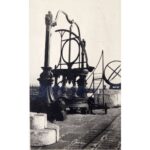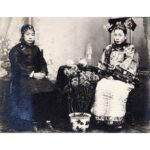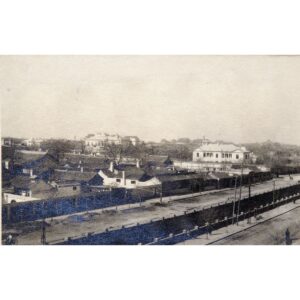Photography Azimuth Theodolite in the Ancient Beijing Observatory
A black-and-white photograph showing a close-up of the azimuth theodolite (diping jingweiyi 地平經緯儀), an astronomical measuring instrument at the old Beijing Observatory Gu Guanxiangtai 北京古觀像台. In the background is the equatorial armillary sphere (chidao jingweiyi 赤道經緯儀). Most of the instruments still preserved today, including those in Skušek’s album of photographs, were made by Jesuits in the 17th and 18th centuries. The azimuth theodolite is designed for measuring the azimuth of celestial bodies. The theodolite stands on a richly decorated stand supported by a wide frame decorated with inlays. The instrument weighs 7,368 kilograms, is 4,125 metres high and has a radius of slightly less than two metres. The instrument is one of eight astronomical measuring instruments currently on display at the observatory – now a museum.
The Old Beijing Observatory is one of the few observatories from the period before the invention of the telescope that ... more
A black-and-white photograph showing a close-up of the azimuth theodolite (diping jingweiyi 地平經緯儀), an astronomical measuring instrument at the old Beijing Observatory Gu Guanxiangtai 北京古觀像台. In the background is the equatorial armillary sphere (chidao jingweiyi 赤道經緯儀). Most of the instruments still preserved today, including those in Skušek’s album of photographs, were made by Jesuits in the 17th and 18th centuries. The azimuth theodolite is designed for measuring the azimuth of celestial bodies. The theodolite stands on a richly decorated stand supported by a wide frame decorated with inlays. The instrument weighs 7,368 kilograms, is 4,125 metres high and has a radius of slightly less than two metres. The instrument is one of eight astronomical measuring instruments currently on display at the observatory – now a museum.
The Old Beijing Observatory is one of the few observatories from the period before the invention of the telescope that have survived to the present day. The site covers 10,000 square metres with a main brick platform measuring 40 by 40 metres and 15 metres high. Today, the observatory is a museum open to the public. It was built during the reign of Emperor Kangxi 康熙 (reigned 1661–1722) – on the foundations of a 12th-century precursor. Renovations were carried out under the supervision of Flemish Jesuit and missionary Father Ferdinand Verbiest (1623–1688). In 1900 the observatory was looted by the French invaders, but in 1902 the instruments were returned “to their place”. In 1956 the observatory became a museum.
The photograph is the 169th of 449 photographs of Beijing and its surroundings in the album of Ivan Skušek Jr., purchased during his stay in Beijing (1914–1920). In the handwritten inventory of the album, the photograph is referred to as Sternwarte: Sextant. (DZ, MV)





































Do you have a comment or additional information about the subject?